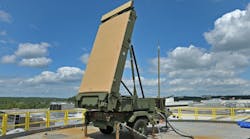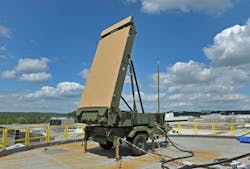Early results on the performance of the AN/TPS-80 Ground/Air Task-Oriented Radar (G/ATOR) system have been impressive (see photo). During recent testing by system designer Northrop Grumman Corp. and the U.S. Marines, the ground weapon locating radar (GWLR) was evaluated for its capability to detect and track multiple types of rocket, artillery, and mortar (RAM) rounds simultaneously.
More than 700 live shots were fired, and the radar system was used to track multiple weapons in over 40 different weapons scenarios. In fact, it successfully detected projectiles at distances between 6 and 50 km, including volley fire in rapid sequences.
“GWLR mode detects and tracks time-critical incoming threats, calculates an approximate impact point, and then tracks the threat’s trajectory back in time to estimate a firing position, allowing counterfire forces to engage rapidly,” said Roshan Roeder, vice president for mission solutions at Northrop Grumman. “The volley fire capability that G/ATOR demonstrated is critical on the modern battlefield, and all of the data collected during IIE indicates that GWLR can exceed the U.S. Marine Corps’ range capability.”
The G/ATOR system employs software that allows it to track and identify projections, whether with a 360-deg. scan in a focused sector. The versatile multiple-mission system is designed to replace a number of legacy U.S. Marine Corps radar systems.


